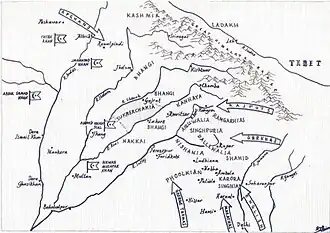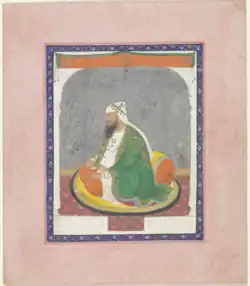Singhpuria Misl
Singhpuria Misl ਸਿੰਘਪੁਰੀਆ ਮਿਸਲ Singhpurī'ā Misal | |||||||||||||
|---|---|---|---|---|---|---|---|---|---|---|---|---|---|
| 1733–1816 | |||||||||||||
 Faizulpuria Misl within the Sikh Confederacy | |||||||||||||
| Capital | Jalandhar | ||||||||||||
| Common language | Punjabi | ||||||||||||
| Religion | |||||||||||||
| Misldar | |||||||||||||
• 1733–1753 | Kapur Singh | ||||||||||||
• 1753–1795 | Khushal Singh | ||||||||||||
• 1795–1816 | Buddh Singh | ||||||||||||
| Historical era | Early modern period | ||||||||||||
• Established | 1733 | ||||||||||||
• Disestablished | 1816 | ||||||||||||
| |||||||||||||
| Today part of | |||||||||||||
| Misls of the Sikh Confederacy |
|---|
 |
Singhpuria Misl, also known as the Faizulpuria Misl[1], was one of the twelve misls of the Sikh Confederacy.[2] It founded by the Sikh warrior Nawab Kapur Singh, who was born in1697 and later became a prominent Dal Khalsa leader.[3] The misl took its original name from a village Faizullapur in Amritsar and then changed the name of the village to Singhpura, with the misl eventually following.
History
The misl was founded by Jats.[2] Nawab Kapur Singh, a leader of the misl and its founder, fought many battles.[3] The Battle of Sirhind (1764) was a turning point of Singhpuria Misl. After the fall of Sirhind a considerable portion of present-day Rupnagar District came under the Singhpuria Misl.[4]
By 1769, the Singpuria Misl had the following territories in its possession:- Some parts of the districts of Jalandhar and Hoshiarpur in Doaba, Kharparkheri and Singhpura in Bari-Doab and Abhar, Adampur, Chhat, Banoor, Manauli Ghanauli, Bharatgarh, Kandhola, Chooni, Machhli Bhareli, Banga, Bela, Attal Garh and some other places in the province of Sirhind.[5]
Territory
The misl originated from Faizalpur near Amritsar.[2] The Faizulpuria Misl controlled areas along the right-bank of the Beas river and on both banks of the Sutlej, controlling settlements such as Ludhiana, Jalandar, Nurpur, and northwestern Ambala.[6] They Faizulpurias held territory in the Jalandhar Doab and accepted tributes from the Delhi region.[2]
Leaders
| No. | Name | Portrait | References |
|---|---|---|---|
| 1 | Nawab Kapur Singh | 
|
[5][2] |
| 2 | Khushal Singh | 
|
[2] |
| 3 | Budh Singh | [2] |
References
- ^ Chhabra, G. S. (1972). "Chapter 1: The Ancestors of Maharaja Ranjit Singh". Advanced History of the Punjab: Ranjit Singh & post Ranjit Singh period. Advanced History of the Punjab. Vol. 2 (2nd ed.). New Academic Publishing Company. pp. 1–13.
- ^ a b c d e f g Dhavan, Purnima (2011). When Sparrows Became Hawks: The Making of the Sikh Warrior Tradition, 1699-1799. Oxford University Press. pp. 60–61. ISBN 978-0-19-975655-1.
- ^ a b Singha, Dr H. S. (2005). Sikh Studies. Hemkunt Press. p. 25. ISBN 978-81-7010-258-8.
- ^ Punjab (India) (1987). Punjab District Gazetteers: Rupnagar. Controller of Print. and Stationery. p. 77.
- ^ a b Markovits, Claude (1 January 2002). A History of Modern India, 1480-1950. Prabhat Prakashan. ISBN 978-93-5266-745-1.
- ^ Herrli, Hans (2004). "The Sikh Misls". The Coins of the Sikhs (2nd ed.). Munshiram Manoharlal. pp. 11–13. ISBN 9788121511322.